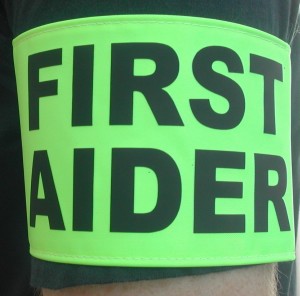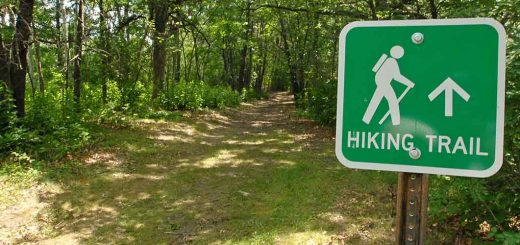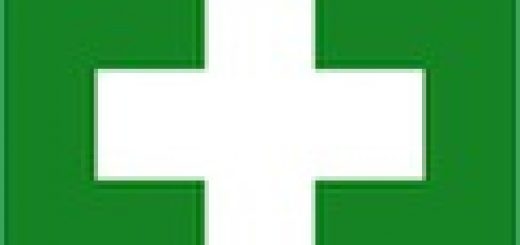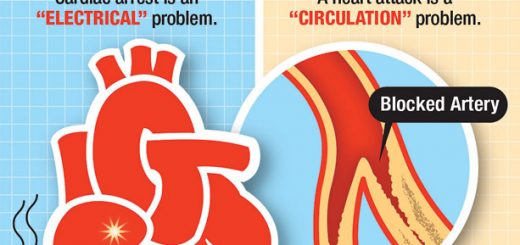Multiple Choice First Aid Questions

Here are some multiple choice first aid questions for you to test your first aid knowledge with! The answers to these questions are at the end of this post.
If you want to learn more about first aid before trying these questions then check out our range of free online first aid courses.
First Aid Multiple Choice Questions
1) How should you open the airway of an unconscious casualty?
A. Head tilt and chin lift.
B. Jaw thrust.
C. Head tilt and jaw thrust.
D. Lift the chin.
2) How long would you check to see if an unconscious casualty is breathing normally?
A. No more than 10 seconds.
B. Approximately 10 seconds.
C. Exactly 10 seconds.
D. At least 10 seconds.
3) You are a lone first aider and have an unconscious non-breathing adult, what should you do first?
A. Start CPR with 30 chest compressions.
B. Give five initial rescue breaths.
C. Call 911/112 requesting AED (defibrillator) and ambulance.
D. Give two initial rescue breaths.
4) Which is the correct ratio of chest compressions to rescue breaths for use in CPR of an adult casualty?
A. 2 compressions : 30 rescue breaths.
B. 5 compressions : 1 rescue breath.
C. 15 compressions : 2 rescue breaths.
D. 30 compressions : 2 rescue breaths.
5) Which of the following is the correct sequence for the chain of survival?
A. 911/112. CPR. Defibrillation. Advanced care.
B. CPR. Defibrillation. 911/112. Advanced care.
C. Defibrillation. CPR. 911/112. Advanced care.
D. Defibrillation. 911/112. CPR. Advanced care.
6) What is the cause of angina?
A. Insufficient blood reaching the lungs.
B. Insufficient blood reaching the brain.
C. Insufficient blood reaching the heart muscle.
D. Insufficient blood reaching the leg muscles.
7) What should a casualty with a severe allergy carry at all times?
A. Insulin.
B. Acetaminophen/Paracetamol.
C. Adrenaline (Epipen).
D. Aspirin.
8) Which test should you use if you suspect that a casualty has had a stroke?
A. Face, Arms, Speech, Test.
B. Alert, Voice, Pain, Unresponsive.
C. Response, Airway, Breathing, Circulation.
D. Pulse, Respiratory Rate, Temperature
9) Which of the following can cause a stroke?
A. A blood clot in an artery in the brain.
B. A blood clot in an artery in the heart.
C. A blood clot in an artery in the leg.
D. A blood clot in an artery in the lungs.
10) What should your first action be when treating an electrical burn?
A. Ensure that the casualty is still breathing.
B. Wash the burn with cold water.
C. Check for danger and ensure that contact with the electrical source is broken.
D. Check for level of response.
11) What is an open fracture?
A. A fracture in which the bone ends can move around.
B. A fracture in which the bone is exposed as the skin is broken.
C. A fracture which causes complications such as a punctured lung.
D. A fracture in which the bone has bent and split.
12) Which medical condition will develop from severe blood loss?
A. Shock.
B. Hypoglycaemia.
C. Anaphylaxis.
D. Hypothermia.
13) What names are given to the three different depths of burns?
A. Small, medium and large.
B. First, second and third degree.
C. Minor, medium and severe.
D. Superficial, partial thickness, full thickness.
14) What is a faint?
A. A response to fear.
B. An unexpected collapse.
C. A brief loss of consciousness.
D. A sign of flu.
15) What steps would you take to control bleeding from a nosebleed?
A. Sit casualty down, lean forward and pinch soft part of nose.
B. Sit casualty down, lean backward and pinch soft part of nose.
C. Lie casualty down and pinch soft part of nose.
D. Lie casualty down and pinch top of nose.
16) What would be the required first aid in case someone suffers a deep wound while playing?
A. Call the doctor
B. Anesthesia
C. Stop bleeding
D. Stitch the wound
17) How many compressions and breaths should you do for each cycle of CPR?
A. 15 compressions, 2 breaths
B. 30 compressions, 5 breaths
C. 30 compressions, 2 breaths
D. 15 compressions, 5 breaths
E. 30 compressions, 15 breaths
18) What should be your first action when examining the condition of a patient?
A. Check for breathing
B. Check for insurance
C. Speak to the victim and shake their shoulders
D. Check for external injuries
19) What is the main purpose of the Heimlich maneuver?
A. To remove a blockage in the victim’s airway
B. To ensure the victim begins to breathe again
C. To treat insufficient breathing
20) How can you recognize if a vein is bleeding?
A. Blood flows equally out of the wound
B. Blood flows with pulses out of the wound
C. Blood flows slowly out of the wound
21) What should be done when someone gets a small cut?
A. Wash with soap and water and cover with a sterile bandage
B. Only cover with a sterile bandage
C. Clean the wound with cotton wool
22) What are the symptoms of hypothermia?
A. Feeling warm and sweaty
B. Feeling cold and sweaty
C. Feeling tired and cold, experiencing shivers, and acting abnormally
D. Being very sweaty
23) How do you check someone’s breathing?
A. Listen carefully
B. Check if their chest is rising
C. Feel with the cheek
D. Watch for chest movement, listen carefully, and feel for breath on your cheek
24) What are the requirements for a cover bandage?
A. It should not absorb any fluids
B. It should not be older than a year
C. It must be sterile
25) What should you do when someone suffers swelling from a head injury?
A. Use a cold compress
B. Use a hot compress
C. Medication
D. Leave it alone
First aid multiple choice answers
- A
- A
- C
- D
- A
- C
- C
- A
- A
- C
- B
- A
- D
- C
- A
- C
- C
- C
- A
- A
- A
- C
- D
- C
- A
Conclusion
Being aware of the basics of first aid is crucial for every person. Whether it’s someone you know or a stranger you encounter on the road, knowing what to do can help you save another person’s life.
We hope the questions listed above and the corresponding answers help you learn something new so that you can apply the newfound knowledge to prevent someone’s condition from getting worse.
How well did you do?
Let us know in the comments.





